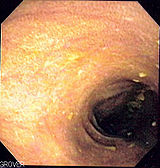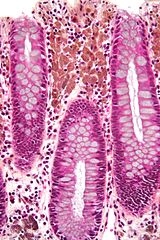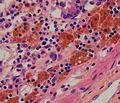- Melanosis coli
-
Melanosis coli, also pseudomelanosis coli, is a disorder of pigmentation of the wall of the colon, often identified at the time of colonoscopy. It is benign, and may have no significant correlation with disease. The brown pigment is lipofuscin in macrophages, not melanin.
Contents
Etiology
The most common cause of melanosis coli is the extended use of laxatives, and commonly anthraquinone containing laxatives such as Senna and other plant glycosides.[1] However, other causes are identified, including an increase in colonic epithelial apoptosis.[2] Endoscopically, the mucosa may show a brownish discoloration in a moire pattern.
Histologic appearance
On biopsy, melanosis coli shows characteristic pigment-laden macrophages within the mucosa on PAS staining.[3]
The histologic differential diagnosis of mucosal pigmentation is: lipofuscin (melanosis coli), hemosiderin-laden macrophages, and melanin (rare).
Prognosis
No adverse effects or consequences of melanosis coli have been identified.[3]
Relation to true melanoses
The condition is unrelated to true melanoses, such as Peutz-Jeghers syndrome and smoker's melanosis.[4]
Peutz-Jegher syndrome causes pigmentation of the skin and mucous surfaces with melanin, and polyps in the digestive tract.
Non-colonic pseudomelanoses
Pseudomelanoses of other parts of the gastrointestinal tract have also been reported, and are of unclear relevance.[5]
Patients with colostomies can have melanosis involving the stoma, which is also of no significance.[6]
Additional images
-
Micrograph showing melanosis coli, which appears as brown pigmentation in the macrophages in the lamina propria.
-
Micrograph of melanosis coli. H&E stain.
-
Micrograph of melanosis coli. H&E stain.
References
- ^ Müller-Lissner, SA. (Oct 1993). "Adverse effects of laxatives: fact and fiction.". Pharmacology 47 Suppl 1: 138–45. doi:10.1159/000139853. PMID 8234421.
- ^ Byers, R.J.; Marsh, P.; Parkinson, D.; Haboubi, N.Y (October 2003). "Melanosis coli is associated with an increase in colonic epithelial apoptosis and not with laxative use". Histopathology 30 (2): 160–164. doi:10.1046/j.1365-2559.1997.d01-574.x. PMID 9067741.
- ^ a b Wittoesch, JH.; Jackman, RJ.; McDonald, JR.. "Melanosis coli: general review and a study of 887 cases.". Dis Colon Rectum 1 (3): 172–80. PMID 13537819.
- ^ Vellappally, S.; Fiala, Z.; Smejkalová, J.; Jacob, V.; Somanathan, R. (2007). "Smoking related systemic and oral diseases.". Acta Medica (Hradec Kralove) 50 (3): 161–6. PMID 18254267.
- ^ Ghadially, FN.; Walley, VM. (Sep 1994). "Melanoses of the gastrointestinal tract.". Histopathology 25 (3): 197–207. doi:10.1111/j.1365-2559.1994.tb01319.x. PMID 7821887.
- ^ Fleischer, I.; Bryant, D. (May 1995). "Melanosis coli or mucosa ischemia? A case report.". Ostomy Wound Manage 41 (4): 44, 46–7. PMID 7598783.
External links
- Endoscopic video of Melanosis coli, via the DAVE Project
Categories:- GI tract disorders
-
Wikimedia Foundation. 2010.





